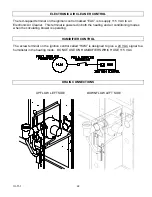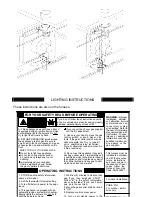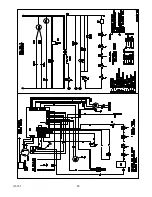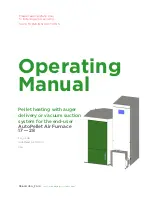
IO-151
19
•
The vent pressure switch will close when it detects a pressure in excess of it’s setting. If the
pressure switch fails to close the status light will flash three (3) times. The sequence cannot
continue until the pressure switch closes.
•
The flame rollout switches are then checked to assure that they are in the closed position.
•
After a pre-purge of about fifteen (15) seconds the electronic ignition device will be energized.
•
After a slight delay the gas valve will open if the flame rollout swithches are closed.
•
The burners will ignite and the flame sensor will detect the presence of flame. The ignition
device will deenergize. If the sensor does not detect the burner flame, the gas valve will close
and the ignition cycle will be repeated for a total of three attempts. If, after the third attempt,
the presence of flame is not detected, the furnace will go into a lockout condition for one (1)
hour. It will then repeat the ignition cycle. This one (1) hour lockout and retry will occur
indefinitely.
•
Thirty (30) seconds after the main valve is energized the circulating air blower will be activated.
•
The furnace will remain in operation until the demand for heat is satisfied.
•
Once the demand is satisfied the venter will shut off, and the circulating air blower will shut off
after the field selectable time off is attained.
•
The furnace will remain dormant until the next demand for heat.
COOLING MODE
•
A demand for cooling is initiated.
•
The control checks for an open limit. If an open limit is detected the furnace will remain
inoperable until the condition is corrected. During an open limit condition the circulating air
blower will be energized. The status light will blink four (4) times.
•
The condenser contactor will close.
•
After approximately five (5) seconds the circulating air blower will start on the cooling speed.
•
After the room thermostat is satisfied the condenser contactor will open.
•
The circulating air blower will remain in operation for approximately sixty (60) seconds.
REMOVING AN EXISTING APPLIANCE
When replacing an existing appliance, the resulting installation must comply with all local codes,
or in the absence of local codes, to the National Fuel Gas Codes ANSI Z223.1 and/or CAN/CGA
B149 Installation Codes as well as these installation instructions.
If the installation of this GMPN furnace requires that an existing appliance be removed from a
venting system which still serves another gas fired appliance this may require that the existing
vent be re-sized. The following steps shall be performed with each appliance connected to the
venting system placed in operation while any other appliance connected to the venting system are
not in operation;
a) Seal any unused openings in the venting system;
b) Inspect the venting system for proper size and horizontal pitch, as required in the National Fuel
Gas Code, ANSI Z223.1 or the CAN/CGA B149 Installation Codes and these instructions.
Determine that there is no blockage or restriction, leakage, corrosion and other deficiencies which
could cause an unsafe condition;
c) In so far as practical close all building doors and windows and all doors between the space in
which the appliance(s) connected to the venting system are located and other spaces in the







































